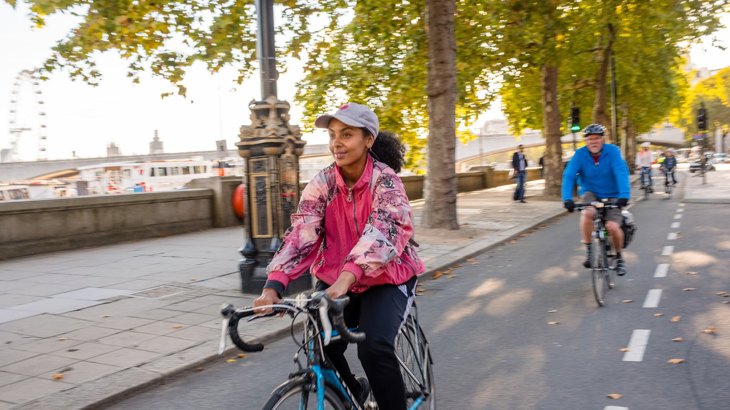We welcome Transport for London's proposed safety improvements at Battersea Bridge, but believe they should go much further.

Credit: photojB
We are custodians of the National Cycle Network.
National Cycle Network Route 4 runs along the Embankment on the north side of the Thames in this area.
National Cycle Network Route 4
National Route 4 is in need of improvement along the section between Putney Bridge and Lambeth Bridge.
The shared space footway proposed is a poor compromise at this location.
Good quality walking and cycling routes where motor traffic and people walking, wheeling and cycling are separated are needed in this area to enable local journeys and need to be planned and delivered in the context of existing and planned routes in the area.
We would like to understand the plan for improvements in this area and are open to either realigning or redesigning Route 4 to achieve the best quality route to meet our Paths for Everyone standards.
Early release
We recommend providing early release for people cycling at all the controlled junctions, in order to reduce the likelihood of hooking manoeuvres.
Reduced footway space
We are disappointed to see, at the new signalised junction between Battersea Bridge Road and Battersea Church Road, that the footway space has been reduced to increase motor vehicle junction capacity.
Banned turns
We appreciate that banning turns for motor vehicles is a way to improve safety for people walking and cycling.
However, this will have an impact on the viability of future low-traffic neighbourhoods in the area.
Transport for London (TfL) should implement fully protected junctions as recommended by LTN 1/20 and implemented in Manchester and Waltham Forest, in order to guarantee safety without displacing traffic onto residential streets.
Healthy Streets Designers Check
The Healthy Streets Designers Check was not published with the consultation documentation. This should be standard practice for TfL schemes, and in particular at dangerous junctions.
Our response is structured as follows:
- Consultation aims
- Scheme design by section
Consultation aims
We support the primary aim of this consultation – to improve safety at the junction, particularly in light of the tragic death at the northern junction of Battersea Bridge in early-2021.
Scheme design by section
Battersea Bridge (north side)
We recommend investigating installing a fully protected junction layout, without relying on banned turns, which can displace traffic to residential streets.
If this is not possible, the proposed shared area at the corner between Beaufort Street and Cheyne Walk could be avoided, with a left turn ban ‘except cycles’.
This would avert confusion of people cycling, who may continue to use the footway eastbound along Chelsea Embankment, with no clarity that this shared section is only meant for northbound cycling.
If this means reducing the buildout on Cheyne Walk to provide a slightly larger radius on the corner of the junction to enable cycle left turns, this is likely preferable to a shared footway.
We recommend early release for people cycling on all arms of the junction.
Bollards along the shared path around Putney bridge reduce the effective width of the shared path, which is very constrained at points.
Reviewing and removing as many bollards as possible at these locations is recommended.
Light protection on the eastbound cycle lane approach to the junction would be welcome and help ensure only people cycling use this space.
We recommend adding cycle lane markings to TSRGD Diag 1057, where people cycling are expected to assume the primary position in the lane, and taking a consistent approach to ‘bus lane and cycles’ markings to avoid confusion.
At the eastern end of the scheme, a central island is proposed to be relocated.
The central island is proposed to be moved too far to the east - we recommend relocating the central island to the west of the junction with Danvers Street.
We also recommend adding dropped kerbs and new tactiles (they are not existing as the drawing indicates).
It is unclear whether an uncontrolled crossing is appropriate based on no data on the traffic flow of the road, but it seems unlikely.
Battersea Bridge (south side)
We are disappointed that the northern footway width at the new signalised crossing at the junction between Battersea Bridge Road and Battersea Church Road has been reduced to increase junction capacity.
It looks as though this will also mean the removal of cycle parking outside the Tesco, which will discourage cycle trips to the store.
We recommend early release for people cycling at all signalised junctions.
The carriageway could be narrowed at bus stop BD to provide cycle infrastructure.
If this is not possible due to space constraints, cycle symbols should be provided at minimum on the outside of the bus stop to alert drivers to their presence.
We recommend adding cycle lane markings to TSRGD Diag 1057, where people cycling are expected to assume the primary position in the lane, and taking a consistent approach to ‘bus lane and cycles’ markings to avoid confusion.





